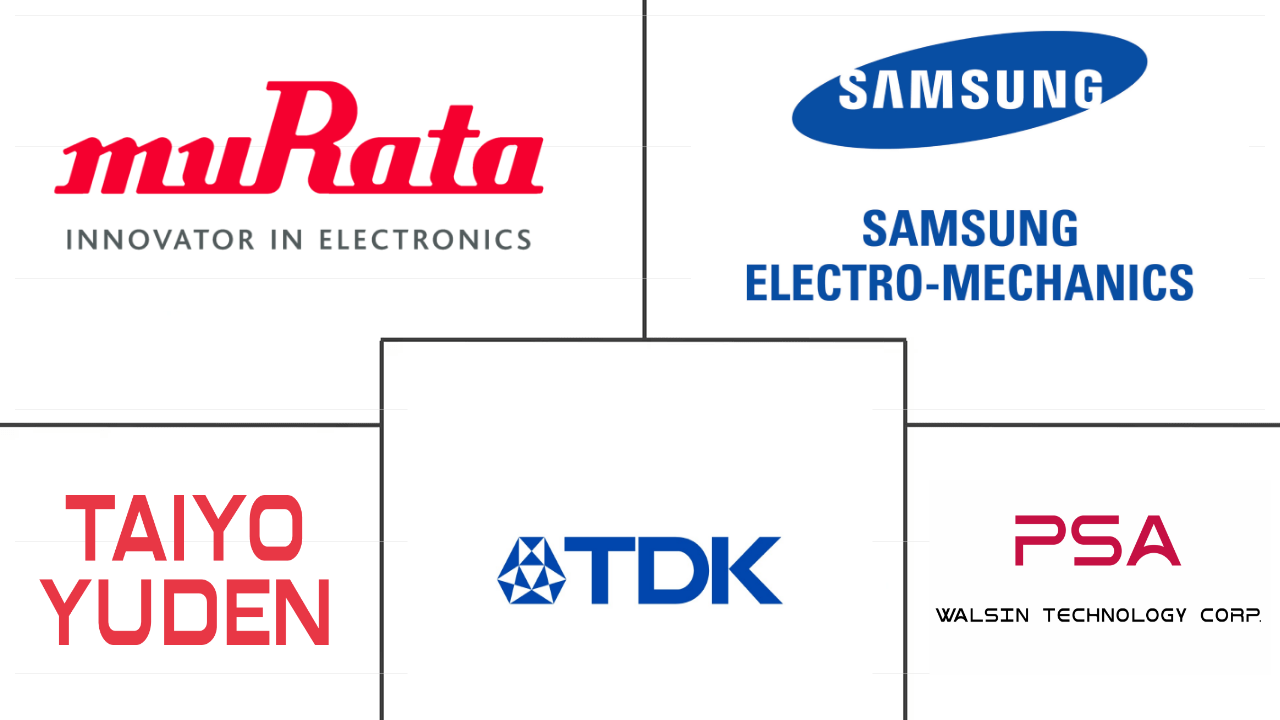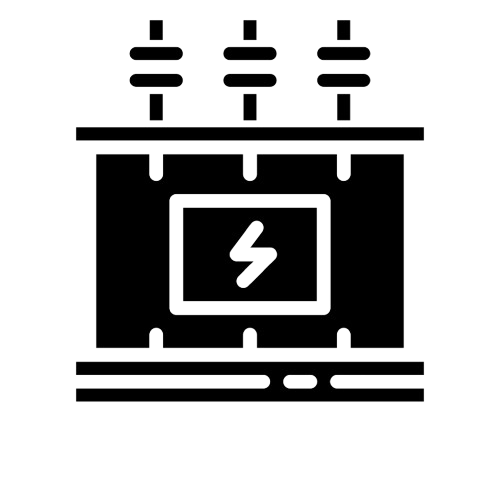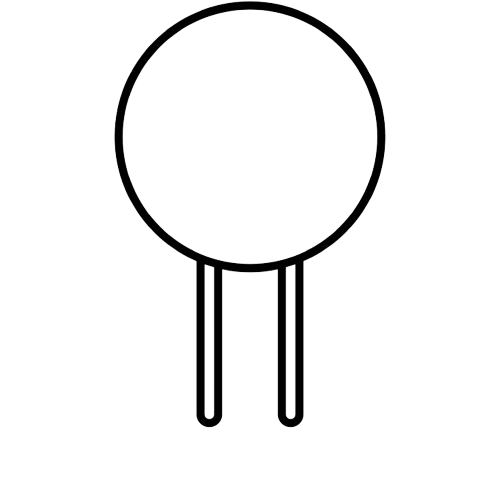Market Size of asia-pacific mlcc Industry
| Icons | Lable | Value |
|---|---|---|
|
|
Study Period | 2017 - 2029 |
|
|
Market Size (2024) | USD 13.29 Billion |
|
|
Market Size (2029) | USD 35.63 Billion |
|
|
Largest Share by Case Size | 0 201 |
|
|
CAGR (2024 - 2029) | 21.81 % |
|
|
Largest Share by Country | China |
|
|
Market Concentration | High |
Major Players |
||

|
||
|
*Disclaimer: Major Players sorted in no particular order |
Asia-Pacific MLCC Market Analysis
The Asia-Pacific MLCC Market size is estimated at 13.29 billion USD in 2024, and is expected to reach 35.63 billion USD by 2029, growing at a CAGR of 21.81% during the forecast period (2024-2029).
13.29 Billion
Market Size in 2024 (USD)
35.63 Billion
Market Size in 2029 (USD)
15.41 %
CAGR (2017-2023)
21.81 %
CAGR (2024-2029)
Largest Segment by Case Size
38.74 %
value share, 0 201, 2023
The ongoing miniaturization trend in consumer electronics like smartphones due to technological advancements like 5G is increasing the demand for compact 0201 case sizes.
Fastest Segment by Voltage
21.82 %
Projected CAGR, Less than 500V, 2024-2029

The growing deployment of 5G technology across the region and the rising initiatives by a prime regional player to promote AI-powered solutions may drive the less-than-500V MLCC market's growth.
Largest Segment by Capacitance
44.83 %
value share, 100µF to 1000µF, 2023

The demand for solar panel installation has increased significantly due to the region's surging demand for distributed energy systems. Factors such as upcoming solar PV projects and supportive government policies are expected to drive the demand for solar PVs, thereby boosting the demand for 100µF-1000µF MLCCs used in these panels.
Largest Segment by Mounting Type
44.38 %
value share, Metal Cap, 2023

These MLCCs are preferred in industrial automation equipment due to their reliability, stable performance, and ability to withstand harsh environmental conditions.
Largest Segment by Country
25.60 %
value share, China, 2023
China is superior in consumer electronics production as it has strong suppliers and a supply chain infrastructure. Thus, it strengthens the MLCC market by producing a large volume of orders in a relatively short lead time.
The demand for 0 201 MLCCs is driven by the growing demand for consumer electronics and medical equipment in the region
- 0 201 emerged as the frontrunner, capturing the largest market share of 46.85%, followed closely by 1 005 with 16.20% and 0 402 with 12.01% in terms of volume in 2022.
- Dielectrics classified as Class 1 can be divided into C0G, X8G, and U2J. The C0G MLCCs with low-mid range capacitance are becoming increasingly popular in the consumer electronic electronics industry, particularly in smartphones, smartwatches, and other devices, due to the increasing trend toward miniaturization in order to achieve sleeker designs.
- Class 2 dielectric MLCCs are classified into X7R, X5R, and Y5V. These dielectrics are an ideal choice for automotive applications due to their ability to withstand high-voltage conditions and the advancement of features such as Automatic Driver Assistance Systems (ADAS), infotainment systems, and improved battery storage capabilities.
Incentives and discounts are driving the increasing demand for electric vehicles, along with the development of consumer electronics such as augmented reality and virtual reality, which is propelling MLCC demand
- In 2022, China emerged as the frontrunner, capturing the largest market share of 24.79%, followed closely by South Korea with 20.31% and Japan with 12.27% in terms of value.
- The Chinese consumer electronics manufacturing industry is one of the most prominent globally. It is anticipated that the Chinese consumer electronics market will experience rapid growth in the future, driven by the introduction of 5G networks, the proliferation of smart homes, augmented and virtual reality technologies, and the continuous evolution of consumer electronic devices with improved features. As a result, the need for installed multi-layer ceramic capacitors MLCCs of surface mount type with 0201 case sizes with low capacitance of less than 100uF is expected to increase accordingly. Incentives and discounts drive the increasing demand for electric vehicles, and the development of consumer electronics such as augmented reality and virtual reality is propelling the MLCC demand.
- The automotive industry is undergoing a period of rapid technological development, which is leading to an increase in the demand for MLCCs. Generally, an engine-driven vehicle without an automated driving feature requires approximately 3,000 MLCCs, while an electric vehicle requires between 8,000 and 10,000 MLCCs. The automotive sector is a major contributor to India's economic growth and can be seen as a benchmark for the current situation. Additionally, Indian government regulations, incentives, discounts, and awareness about e-mobility are driving consumers toward the purchase of electric vehicles, driving the demand for MLCCs.
Asia-Pacific MLCC Industry Segmentation
Class 1, Class 2 are covered as segments by Dielectric Type. 0 201, 0 402, 0 603, 1 005, 1 210, Others are covered as segments by Case Size. 500V to 1000V, Less than 500V, More than 1000V are covered as segments by Voltage. 100µF to 1000µF, Less than 100µF, More than 1000µF are covered as segments by Capacitance. Metal Cap, Radial Lead, Surface Mount are covered as segments by Mlcc Mounting Type. Aerospace and Defence, Automotive, Consumer Electronics, Industrial, Medical Devices, Power and Utilities, Telecommunication, Others are covered as segments by End User. China, India, Japan, South Korea, Others are covered as segments by Country.
- 0 201 emerged as the frontrunner, capturing the largest market share of 46.85%, followed closely by 1 005 with 16.20% and 0 402 with 12.01% in terms of volume in 2022.
- Dielectrics classified as Class 1 can be divided into C0G, X8G, and U2J. The C0G MLCCs with low-mid range capacitance are becoming increasingly popular in the consumer electronic electronics industry, particularly in smartphones, smartwatches, and other devices, due to the increasing trend toward miniaturization in order to achieve sleeker designs.
- Class 2 dielectric MLCCs are classified into X7R, X5R, and Y5V. These dielectrics are an ideal choice for automotive applications due to their ability to withstand high-voltage conditions and the advancement of features such as Automatic Driver Assistance Systems (ADAS), infotainment systems, and improved battery storage capabilities.
| Dielectric Type | |
| Class 1 | |
| Class 2 |
| Case Size | |
| 0 201 | |
| 0 402 | |
| 0 603 | |
| 1 005 | |
| 1 210 | |
| Others |
| Voltage | |
| 500V to 1000V | |
| Less than 500V | |
| More than 1000V |
| Capacitance | |
| 100µF to 1000µF | |
| Less than 100µF | |
| More than 1000µF |
| Mlcc Mounting Type | |
| Metal Cap | |
| Radial Lead | |
| Surface Mount |
| End User | |
| Aerospace and Defence | |
| Automotive | |
| Consumer Electronics | |
| Industrial | |
| Medical Devices | |
| Power and Utilities | |
| Telecommunication | |
| Others |
| Country | |
| China | |
| India | |
| Japan | |
| South Korea | |
| Others |
Asia-Pacific MLCC Market Size Summary
The Asia-Pacific MLCC market is poised for significant growth, driven by the increasing demand for miniaturized electronic components in consumer electronics and the automotive sector. The market is characterized by a diverse range of dielectric classifications, with Class 1 and Class 2 MLCCs finding applications in smartphones, smartwatches, and automotive systems. The consumer electronics industry, particularly in China, South Korea, and Japan, is a major contributor to market expansion, fueled by advancements in 5G technology, smart home devices, and augmented reality. The automotive industry is also a key driver, with the rising adoption of electric vehicles and advanced driver assistance systems necessitating a higher volume of MLCCs. The market is fairly consolidated, with major players like Murata Manufacturing, Samsung Electro-Mechanics, and TDK Corporation leading the charge.
The market's growth trajectory is supported by the increasing production of light commercial and passenger vehicles, alongside the recovery from pandemic-induced disruptions. The shift towards electric and hybrid vehicles, driven by government policies aimed at reducing carbon emissions, is further propelling the demand for MLCCs. The Asia-Pacific region is witnessing a faster adoption of electric vehicles compared to Western counterparts, enhancing the market's potential. Innovations in MLCC technology, such as those introduced by KEMET and Murata, are catering to the specific needs of automotive applications, including high voltage requirements and miniaturization. These developments underscore the critical role of MLCCs in supporting the evolving landscape of consumer electronics and automotive technologies in the Asia-Pacific region.
Asia-Pacific MLCC Market Size - Table of Contents
-
1. MARKET SEGMENTATION (includes market size in Value in USD and Volume, Forecasts up to 2029 and analysis of growth prospects)
-
1.1 Dielectric Type
-
1.1.1 Class 1
-
1.1.2 Class 2
-
-
1.2 Case Size
-
1.2.1 0 201
-
1.2.2 0 402
-
1.2.3 0 603
-
1.2.4 1 005
-
1.2.5 1 210
-
1.2.6 Others
-
-
1.3 Voltage
-
1.3.1 500V to 1000V
-
1.3.2 Less than 500V
-
1.3.3 More than 1000V
-
-
1.4 Capacitance
-
1.4.1 100µF to 1000µF
-
1.4.2 Less than 100µF
-
1.4.3 More than 1000µF
-
-
1.5 Mlcc Mounting Type
-
1.5.1 Metal Cap
-
1.5.2 Radial Lead
-
1.5.3 Surface Mount
-
-
1.6 End User
-
1.6.1 Aerospace and Defence
-
1.6.2 Automotive
-
1.6.3 Consumer Electronics
-
1.6.4 Industrial
-
1.6.5 Medical Devices
-
1.6.6 Power and Utilities
-
1.6.7 Telecommunication
-
1.6.8 Others
-
-
1.7 Country
-
1.7.1 China
-
1.7.2 India
-
1.7.3 Japan
-
1.7.4 South Korea
-
1.7.5 Others
-
-
Asia-Pacific MLCC Market Size FAQs
How big is the Asia-Pacific MLCC Market?
The Asia-Pacific MLCC Market size is expected to reach USD 13.29 billion in 2024 and grow at a CAGR of 21.81% to reach USD 35.63 billion by 2029.
What is the current Asia-Pacific MLCC Market size?
In 2024, the Asia-Pacific MLCC Market size is expected to reach USD 13.29 billion.

